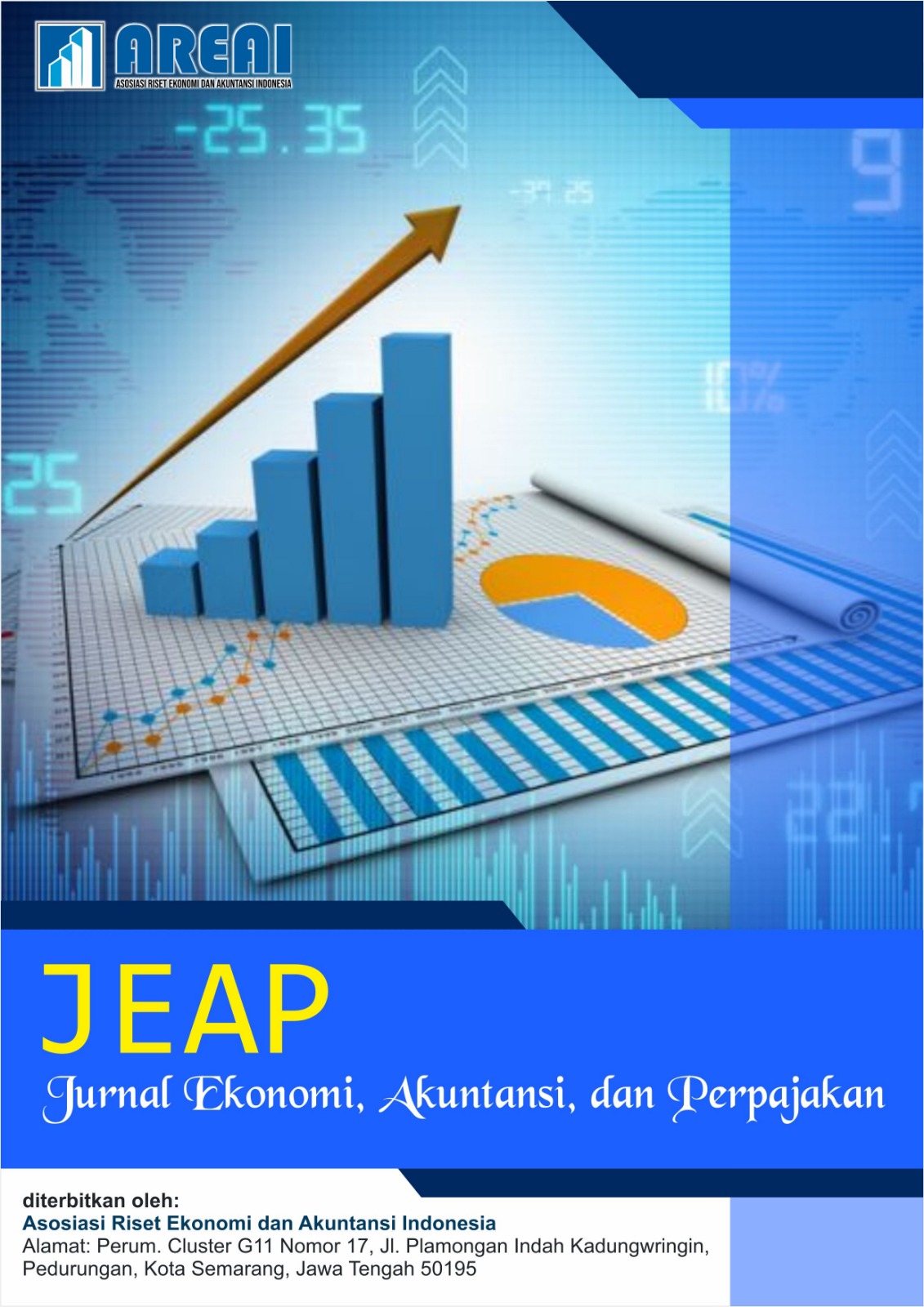Pengaruh Pembelajaran Prakarya dan Kewirausahaan, serta Literasi Ekonomi terhadap Intensi Berwirausaha dengan Efikasi Diri sebagai Variabel Mediasi pada Siswa SMAN di Ciracas
DOI:
https://doi.org/10.61132/jeap.v2i3.1308Keywords:
Economic Literacy, Entrepreneurial Intention, High School Students, Self-EfficacyAbstract
This study aims to analyze the influence of Craft and Entrepreneurship Learning as well as economic literacy on entrepreneurial intention, with self-efficacy as a mediating variable among senior high school students in Ciracas, East Jakarta. The research is grounded in the issue of low entrepreneurial intention among students based on preliminary survey results, and the persistently high unemployment rate among high school graduates. This study adopts a quantitative approach using a survey method through questionnaires distributed to 11th-grade students from three schools: SMAN 99, SMAN 58, and SMAN 105 Jakarta. Data were analyzed using the Partial Least Squares Structural Equation Modeling (PLS-SEM) method. The results indicate that both Craft and Entrepreneurship Learning and economic literacy have a positive effect on self-efficacy and entrepreneurial intention. Moreover, self-efficacy is proven to be a significant partial mediating variable in the relationship between the independent variables and entrepreneurial intention. This research recommends strengthening entrepreneurship education and improving economic literacy in schools as strategies to foster students’ confidence and entrepreneurial spirit from an early age.
Downloads
References
Access, O. (2024). Edukasi: Jurnal Pendidikan dan Pengajaran fostering job creation: Implementing. Edukasi: Jurnal Pendidikan dan Pengajaran, 11(2), 90–101.
Ainur Rizqi, U., Pratikto, H., & Kusdiyanti, H. (2022). Entrepreneurship education and economic literacy mediated by entrepreneurial self-efficacy affect entrepreneurial intention. International Journal of Humanities Education and Social Sciences (IJHESS), 2(1), 190–204. https://doi.org/10.55227/ijhess.v2i1.208
Asdar, A. S., Hasbiah, S., & Mulyadi, A. R. (2024). Do self-efficacy, financial literacy, and digital literacy among students contribute to entrepreneurial behavior through entrepreneurship education? Pinisi Journal of Entrepreneurship Review, 2(1), 32–50. https://doi.org/10.62794/pjer.v2i1.2471
Badan Pusat Statistik. (2024). Tingkat pengangguran terbuka berdasarkan tingkat pendidikan. https://www.bps.go.id/id/statistics-table/2/MTE3OSMy/tingkat-pengangguran-terbuka-berdasarkan-tingkat-pendidikan.html
Bergner, S., Auburger, J., & Paleczek, D. (2023). The why and the how: A nexus on how opportunity, risk and personality affect entrepreneurial intention. Journal of Small Business Management, 61(6), 2656–2689. https://doi.org/10.1080/00472778.2021.1934849
Djazuli, R. F. (2021). Dinamika pengaturan tenaga kerja asing di Indonesia. Adliya: Jurnal Hukum dan Kemanusiaan, 15(1), 1–18. https://doi.org/10.15575/adliya.v15i1.10434
Hair, J. F., Risher, J. J., Sarstedt, M., & Ringle, C. M. (2019). The results of PLS-SEM. European Business Review, 31(1), 2–24.
Hair, J., & Alamer, A. (2022). Partial least squares structural equation modeling (PLS-SEM) in second language and education research: Guidelines using an applied example. Research Methods in Applied Linguistics, 1(3), 100027. https://doi.org/10.1016/j.rmal.2022.100027
Halizah, S. N., Sinambela, E. A., Darmawan, D., & Mardikaningsih, R. (2022). The influence of entrepreneurship education, self-efficacy, locus of control and achievement motivation on entrepreneurial intention. Jurnal Ekonomi dan Kewirausahaan, 2(2), 47–58.
Hassan, N. A. (2020). University business incubators as a tool for accelerating entrepreneurship: Theoretical perspective. Review of Economics and Political Science. https://doi.org/10.1108/reps-10-2019-0142
Joban, Z. (2023). Keputusan berwirausaha dikalangan generasi milenial [Tesis, Universitas Islam Sultan Agung]. https://repository.unissula.ac.id/31233/1/Magister%20Manajemen_20402100050_fullpdf.pdf
Katalinga, G. G., & Artadita, S. (2024). Pengaruh pengetahuan dan motivasi berwirausaha terhadap minat berwirausaha pada siswa SMK Wikrama 1 Garut. Jurnal Pendidikan Ekonomi, 11(6), 5448–5457.
Khasanah, A., Widiastuti, E., & Noviarita, H. (2025). Islamic education entrepreneurship in the digital era: Opportunities, challenges, and innovations. Jurnal Pendidikan Islam, 5(1), 1–12.
Lihua, D. (2022). An extended model of the theory of planned behavior: An empirical study of entrepreneurial intention and entrepreneurial behavior in college students. Frontiers in Psychology, 12(January). https://doi.org/10.3389/fpsyg.2022.627818
Lima, Y., Barbosa, C. E., Dos Santos, H. S., & de Souza, J. M. (2021). Understanding technological unemployment: A review of causes, consequences, and solutions. Societies, 11(2), 1–15. https://doi.org/10.3390/SOC11020050
Mutiara, M., Kurniawan, C., & Pratiwi, N. (2022). Pengaruh literasi ekonomi terhadap perilaku konsumtif siswa SMA Negeri 3 Palembang. Jurnal Pendidikan Ekonomi Undiksha, 14(2), 330–338. https://doi.org/10.23887/jjpe.v14i2.54525
Noni, Y., Fadhilah, N., Norvadewi, N., Yanti, D., & Fitriah, D. (2023). Pelatihan kewirausahaan untuk mengembangkan jiwa entrepreneurship mahasiswa di Kalimantan Timur. Jurnal Pengabdian Kolaborasi dan Inovasi IPTEKS, 1(5), 445–453. https://doi.org/10.59407/jpki2.v1i5.87
Parman, P., Sampara, N., & Fitra, M. (2024). Strategi pemasaran pada produk sarung tenun di Desa Lero Kecamatan Suppa Kabupaten Pinrang. Decision: Jurnal Ekonomi dan Bisnis, 5(1), 22–29. https://doi.org/10.31850/decision.v5i1.2942
Pradanimas, A., & Slamet. (2023). Pendidikan literasi keuangan untuk meningkatkan minat berwirausaha di perguruan tinggi Islam: Peran efikasi diri sebagai faktor mediasi. Indonesian Journal of Humanities and Social Sciences, 4(3), 583–596.
Prawesti, M. I., & Cahya, S. B. (2024). Pengaruh pendidikan kewirausahaan, efikasi diri, dan pola pikir kewirausahaan terhadap intensi berwirausaha mahasiswa Fakultas Ekonomika dan Bisnis Unesa. Jurnal Pendidikan Tata Niaga (JPTN), 12(2), 233–242.
Royhul Akbar, & Ponten, S. (n.d.). Manajemen keuangan PT Mifandi Mandiri Digital. [Laporan Internal Perusahaan].
Saleh, M. A., Fraick, M., Gillian, N., Hasanah, M., Harahap, F. H., & Mangkurat, U. L. (2024). Pendidikan kewirausahaan pada mahasiswa jurusan ilmu pengetahuan sosial. Jurnal Pendidikan Ekonomi, 12(3), 85–92.
Sari, R. T., & Subroto, T. W. (2023). Pengaruh literasi ekonomi, e-commerce, dan lingkungan keluarga terhadap minat berwirausaha mahasiswa. Jurnal Riset Pendidikan Ekonomi, 8(2), 149–161. https://doi.org/10.21067/jrpe.v8i2.8792
Shofwan, I., Sunardi, S., Gunarhadi, G., & Rahman, A. (2023). Entrepreneurship education: Encouraging entrepreneurial intentions for equality education students in Semarang. International Journal of Learning, Teaching and Educational Research, 22(6), 175–194. https://doi.org/10.26803/ijlter.22.6.10
Somyos, A., & Roopsuwankun, P. (2021). The important factors influencing the purchase decision of products via online application (mobile application) of consumers in Bangkok. Apheit International Journal, 10(2), 45–56.
Susetyo, D. P., & Firmansyah, D. (2023). Literasi ekonomi, literasi keuangan, literasi digital dan perilaku keuangan di era ekonomi digital. Economics and Digital Business Review, 4(1), 261–279.
Szabó-Szentgróti, G., Végvári, B., & Varga, J. (2021). Impact of Industry 4.0 and digitization on labor market for 2030—Verification of Keynes’ prediction. Sustainability (Switzerland), 13(14), 1–19. https://doi.org/10.3390/su13147703
Downloads
Published
How to Cite
Issue
Section
License
Copyright (c) 2025 Jurnal Ekonomi, Akuntansi, dan Perpajakan

This work is licensed under a Creative Commons Attribution-ShareAlike 4.0 International License.





